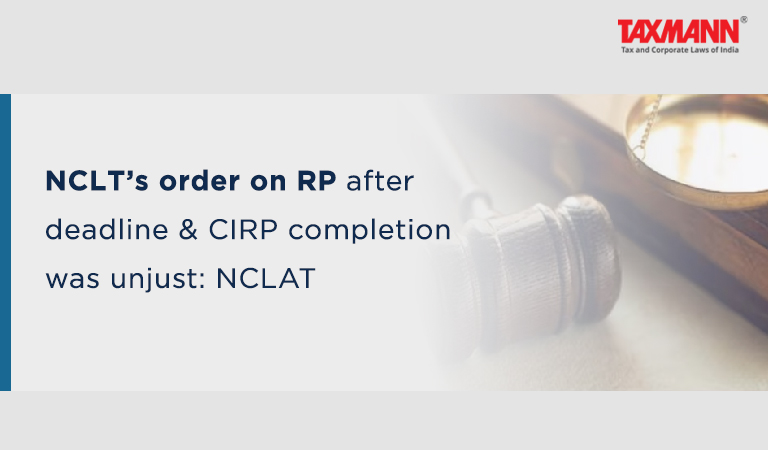NCLT’s order on RP after deadline & CIRP completion was unjust: NCLAT
- Blog|News|Insolvency and Bankruptcy Code|
- 3 Min Read
- By Taxmann
- |
- Last Updated on 8 February, 2023

Case Details: Alok Kailash Saksena, Resolution Professional for Associate Décor Ltd. v. Svamitva Landmarks - [2023] 146 taxmann.com 379 (NCLAT-Chennai)
Judiciary and Counsel Details
-
- M. Venugopal, Judicial Member & Kanthi Narahari, Technical Member
-
Rajasekar Rao, Sr. Adv for the Appellant.
Facts of the Case
In the instant case, Corporate Insolvency Resolution Process (CIRP) was initiated against the corporate debtor and the appellant was appointed as a Resolution Professional (RP). RP invited expressions of interest and plan of METL-SRA was approved by the Committee of Creditors (CoC) with 100 per cent voting.
The RP filed an application before NCLT for approval of the resolution plan. Subsequently, the respondents as a consortium after completion of CIR process submitted their resolution plan to RP who stated that the last date for submission of the resolution plan had already expired on 7-12-2020 and 330 days period of CIRP had also expired.
Therefore, the plan filed on 27-5-2020 i.e. after a lapse of more than 5 months from the last date could not be considered. Consequently, the Respondents filed an application before NCLT seeking direction to be issued to RP to place their plan for consideration before CoC.
The NCLT by impugned order directed RP to place a plan of respondents along with a resolution plan submitted by METL before CoC for its consideration. Consequently, an appeal was preferred to the appellate tribunal.
NCLAT Held
Hon’ble NCLAT observed that the NCLT had no power to consider the resolution plan of a new applicant, who had submitted its plan after the expiry of the last date for submission and that too after the completion of the CIRP period.
Further, it was held that the NCLT exceeded its jurisdiction in directing RP to place a resolution plan of respondents before CoC as the same amounted to interference with commercial wisdom exercised by the CoC in its commercial decision, more particularly, in the absence of any ‘material irregularity’ and ‘violation of any law’ for the time being in force. Therefore, the impugned order passed by NCLT was to be set aside.
List of Cases Reviewed
-
- State of Karnataka v. Alok Kailash Saksena, Resolution Professional for Associate Decor Ltd. [2023] 146 taxmann.com 378 (NCLT – Beng.) (para 51 ) reversed [See Annex].
- Ebix Singapore (P.) Ltd. v. Committee of Creditors of Educomp Solutions Ltd. [2021] 130 taxmann.com 208 (SC)/2012 SCC Online SC 707 (para 50)
- Union Bank of India v. Kapil Wadhwan [2022] 137 taxmann.com 24/171 SCL 344 (NCLAT – New Delhi) (para 46)
- Renganayaki Agencies v. Sreenivasa Rao Ravinuthala [2021] 127 taxmann.com 867/168 SCL 117 (NCLAT – Chennai)/2021 SCC Online NCLAT 136 (para 50) followed.
- Bank of Maharashtra stressed Asset Management branch janmangal v. Videocon industries Ltd. [2022] 134 taxmann.com 55 (NCLAT)/2022 SCC online NCLAT 6 (para 42)
- Dr. Periasamy Palani Gounder v. Radhakrishnan Dharmarajan, Resolution Professional Appu Hotels Ltd. [2022] 135 taxmann.com 319 (NCLAT-Chennai) (para 43) distinguished.
List of Cases Referred to
-
- Centrum Financial Services Ltd. v. CFM Asset Reconstruction (P.) Ltd. [Company Appeal (AT) (Ins.) No 302 of 2021, dated 13-4-2021] (para 10)
- UT Chandigarh Administration v. Amarjeet Singh [2009] 4 SCC 660 (para 11)
- Tarun International Ltd. v. Vikram Bajaj [Company Appeal (AT) (Insolvency) No. 1194 of 2019, dated 3-3-2021] (para 11)
- Quinn Logistics India (P.) Ltd. v. Mack Soft Tech (P.) Ltd. [company appeal (AT) (Insolvency) No. 185 of 2018, dated 8-5-2018] (para 19)
- Noorudding Khan v. Oriental Bank of Commerce [Writ Petition No. 26084 of 2019, dated 8-8-2019] (para 26)
- Committee of creditors of Essar Steel India Ltd. v. Satish Kumar Gupta [2019] 111 taxmann.com 234 (SC)/[2020] 8 SCC 531 (para 33)
- Ebix Singapore (P.) Ltd. v. Committee of Creditors of Educomp Solutions Ltd. [2021] taxmann.com 208 (SC)/2021 SCC Online SC 707 (para 34)
- Bank of Maharashtra stressed asset management branch Janmangal v. Videocon Industries Ltd. [2022] 134 taxmann.com 55 (NCLAT)/2022 SCC online NCLAT 6 (para 42)
- Dr. Periasamy Palani Gounder v. Radhakrishnan Dharmarajan, Resolution Professional Appu Hotels Ltd. [2022] 135 taxmann.com 319 (NCLAT-Chennai) (para 43)
- Renganayaki Agencies v. Sreenivasa Rao Ravinuthala [2021] 127 taxmann.com 867/168 SCC 117 (NCLAT-Chennai)/2021 SCC Online NCLAT 136 (para 45)
- Union Bank of India v. Kapil Wadhawan [2022] 137 taxmann.com 24/171 SCL 344 (NCLAT-New Delhi) (para 46).
Disclaimer: The content/information published on the website is only for general information of the user and shall not be construed as legal advice. While the Taxmann has exercised reasonable efforts to ensure the veracity of information/content published, Taxmann shall be under no liability in any manner whatsoever for incorrect information, if any.

Taxmann Publications has a dedicated in-house Research & Editorial Team. This team consists of a team of Chartered Accountants, Company Secretaries, and Lawyers. This team works under the guidance and supervision of editor-in-chief Mr Rakesh Bhargava.
The Research and Editorial Team is responsible for developing reliable and accurate content for the readers. The team follows the six-sigma approach to achieve the benchmark of zero error in its publications and research platforms. The team ensures that the following publication guidelines are thoroughly followed while developing the content:
- The statutory material is obtained only from the authorized and reliable sources
- All the latest developments in the judicial and legislative fields are covered
- Prepare the analytical write-ups on current, controversial, and important issues to help the readers to understand the concept and its implications
- Every content published by Taxmann is complete, accurate and lucid
- All evidence-based statements are supported with proper reference to Section, Circular No., Notification No. or citations
- The golden rules of grammar, style and consistency are thoroughly followed
- Font and size that’s easy to read and remain consistent across all imprint and digital publications are applied





